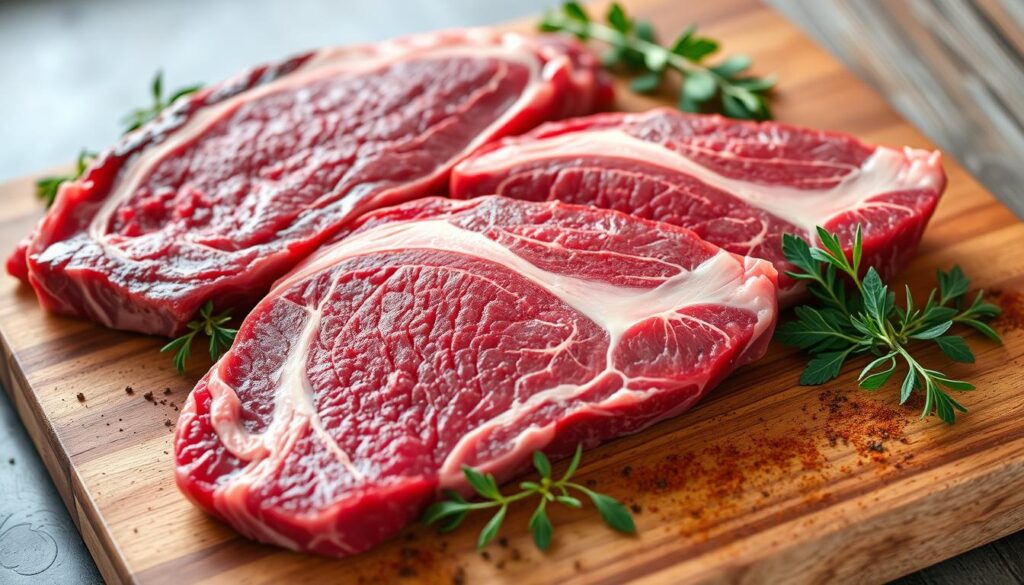Understanding different beef cuts is key for perfect thin-slicing. This guide covers top cuts, meat texture, and essential tools. It’s perfect for both home chefs and professionals.
Whether you’re a seasoned chef or just starting, this guide helps you choose the best beef. You’ll learn about tender, flavorful, and visually appealing thin-sliced beef. Get ready to discover what is the best cuts of beef for thin-slicing for your stir-fries,sandwishes ana asian dishes.
Table of Contents
Understanding the Art of Thin-Slicing Beef
Thinly slicing beef is a true culinary art. The science of meat texture and grain direction is key. It helps achieve the perfect thin-sliced beef that melts in your mouth.
Muscles that are less used, like the tenderloin, yield more tender cuts. On the other hand, tougher areas like the chuck need special preparation to improve their texture.
The Science Behind Meat Texture and Grain
The direction of muscle fibers, or grain, greatly affects the tenderness of thin-sliced beef. Cutting across the grain makes the fibers shorter. This results in a more tender and easy-to-chew texture.
On the other hand, slicing with the grain can make the beef chewier and less tender.
Essential Tools for Thin-Slicing
- A sharp, high-quality knife is essential for achieving clean, precise slices.
- A meat slicer can also be a game-changer, providing consistent thickness and effortless thin-slicing.
Temperature and Cutting Techniques
Temperature control is crucial when thin-slicing beef. Beef that’s partially frozen is easier to slice thinly. This is because the colder temperature helps the meat keep its shape and firmness.
When cutting, move the knife in a smooth, consistent motion. Slice against the grain for the most tender results.
By understanding the science behind meat texture and grain, along with the right tools and techniques, you can master the art of thin-slicing beef. This will elevate your culinary creations to new heights.
What is the Best Cut of Beef to Thinly Slice?
Choosing the right cut of beef for thin-slicing is key. Tenderloin, ribeye, and strip loin are top picks. They offer a mix of tenderness and flavor that’s perfect for slicing thinly.
Tenderloin is a high-end cut known for its tender texture and little connective tissue. This makes it great for thin slices. Rib and ribeye steaks from the rib section are marbled and rich, giving a luxurious taste when sliced thinly.
Strip steaks, also called striploin or New York strips, are a favorite for thin-slicing. They have a good balance of marbling, tenderness, and flavor. Porterhouse and T-bone steaks offer a mix of textures and tastes, combining tenderloin’s tenderness with strip steak’s robust flavor.
Denver and chuck eye steaks are more affordable but still tender and flavorful for thin-slicing. Flatiron steak, from the shoulder chuck, is great for marinating. It has a bold flavor and chewy texture when sliced thinly.
Bistro steaks like hanger, skirt, and flap are also popular. They’re affordable and flavorful when sliced thinly. This makes them versatile for many dishes.
| Cut of Beef | Tenderness | Flavor | Best for Thin Slicing |
|---|---|---|---|
| Tenderloin | Extremely Tender | Mild | ✓ |
| Ribeye | Tender | Rich, Beefy | ✓ |
| Strip Steak | Tender | Beefy | ✓ |
| Porterhouse/T-Bone | Tender | Robust | ✓ |
| Denver/Chuck Eye | Tender | Flavorful | ✓ |
| Flatiron | Moderately Tender | Bold, Beefy | ✓ |
| Bistro Steaks (Hanger, Skirt, Flap) | Moderately Tender | Flavorful | ✓ |
Prime Cuts: Tenderloin and Filet Mignon
When it comes to beef tenderloin and filet mignon, they are the top choices for thin-sliced steak. Known for their softness and fine texture, these premium cuts make for a luxurious meal.
Preparing Tenderloin for Slicing
To get perfect thin slices of beef tenderloin, first remove the silverskin and trim off any extra fat. Freezing the tenderloin a bit can also help. This makes it easier to cut into very thin pieces, ensuring each slice looks great.
Temperature Control Tips
Keeping the right temperature is key when handling filet mignon and beef tenderloin. The best temperature is between 35-40°F. This keeps the meat tender and easy to slice.
Serving Suggestions
- Serve thin-sliced beef tenderloin in a classic carpaccio style. Add arugula, Parmesan, and olive oil for extra flavor.
- Thin-sliced filet mignon is perfect for fancy sandwiches or charcuterie boards. It highlights its rich taste.
- Enjoy these premium cuts rare to medium-rare. This way, you get the best texture and flavor.
Ribeye and Strip Loin Options
When it comes to thin-slicing beef, two exceptional choices stand out: ribeye and strip loin. These cuts offer a delightful balance of marbling, flavor, and tenderness. They are ideal for a variety of culinary applications.
Ribeye steaks are renowned for their juicy and well-marbled texture. They provide a rich, beefy flavor that shines in thin slices. The generous fat content ensures each bite is tender and flavorful, perfect for dishes like stir-fries, Philly cheesesteaks, or carpaccio.
Strip loin, also known as the New York strip, is another top contender for thin-slicing. This cut boasts a balanced profile, delivering both tenderness and a robust beefy taste. Whether you’re preparing Asian-inspired dishes or classic Philly cheesesteaks, the strip loin’s versatility makes it a go-to choice.
When slicing these premium cuts, pay close attention to the direction of the grain. Cutting against the grain is the key to ensuring your thin-sliced beef remains tender and easy to chew, no matter the preparation method.
| Cut | Flavor Profile | Best Uses |
|---|---|---|
| Ribeye Steak | Rich, juicy, and well-marbled | Stir-fries, Philly cheesesteaks, carpaccio |
| Strip Loin / New York Strip | Balanced, tender, and beefy | Asian-inspired dishes, Philly cheesesteaks |
Flank and Skirt Steak: Popular Asian-Style Choices
Flank and skirt steak are top picks for Asian-inspired dishes. They have bold flavors and are great for quick cooking. This makes them tender and juicy, perfect with Asian seasonings.
Marinating Methods
To make flank or skirt steak more tender, marinate it for 2-8 hours. Acidic ingredients like citrus or vinegar help soften the meat. They also add Asian flavors. Soy sauce, brown sugar, garlic, ginger, and sesame oil are common marinade ingredients.
Optimal Cooking Times
Cook flank and skirt steaks quickly over high heat. Grill or skillet cooking for 3-5 minutes per side works best. This way, they stay juicy and tender.
Slicing Against the Grain
When slicing flank steak or skirt steak, cut against the grain at a 45-degree angle. This makes the meat tender and easy to chew.
Flank steak and skirt steak are great for many Asian dishes. They’re perfect for beef and broccoli, fajitas, and Korean bulgogi.
Denver and Chuck Eye: Budget-Friendly Alternatives
Looking for thin-sliced beef without spending a lot? Denver steak and chuck eye are great choices. Denver steak comes from the under the shoulder blade and is very tender. Chuck eye, from the shoulder, is like a ribeye but cheaper.
Both Denver steak and chuck eye are best when sliced thin against the grain. This makes them tender and perfect for fast dishes like stir-fries or fajitas. They’re a budget-friendly option compared to pricier cuts.
| Cut | Average Price per Pound | Comparison to Boneless Ribeye |
|---|---|---|
| Chuck Eye Steak | $9.44 | 25% cheaper |
| Denver Steak | $10.04 | 20% cheaper |

Next time you want a quick, tasty meal, try Denver steak or chuck eye. These tender chuck cuts are affordable and full of flavor.
Sirloin Cuts: Versatility for Thin-Slicing
The sirloin family is perfect for thin-slicing. They are tender, flavorful, and affordable. Top and bottom sirloin cuts are great for stir-fries, fajitas, and roast beef sandwiches.
Top Sirloin Preparation
The top sirloin is the leanest and most tender. It’s located near the short loin. To slice it, trim fat and cut against the grain.
This cut is perfect for quick cooking. It’s great in stir-fries, tacos, or on salads.
Bottom Sirloin Uses
The bottom sirloin, like the tri-tip, has more flavor and texture. It’s a bit tougher but works well with longer cooking or marinating. Thinly sliced, it’s perfect for versatile beef cuts in stir-fries, fajitas, or roast beef sandwiches.
Choose the lean top sirloin or the flavorful bottom sirloin. Both versatile beef cuts will make your thin-slicing better. Try different cooking methods and flavors to find your favorite way to enjoy these lean beef options.
Special Considerations for Frozen Beef
Thin-slicing frozen beef needs a bit more care, but it’s worth it. The trick is to partially thaw the meat until it’s firm but not fully thawed. This keeps the slices thin and even.
When slicing partially frozen beef, use a sharp knife and apply steady pressure. Don’t refreeze thawed meat to keep it safe. Sliced frozen beef is great for stir-fries or can be stored for later.
Thawing Techniques for Thin-Slicing
- Let the beef sit at room temperature for 30-60 minutes until it’s slightly softened but still firm inside.
- Put the frozen beef in the fridge for 8-12 hours to thaw slowly and safely.
- Use a cold water bath, changing the water every 30 minutes, to thaw the beef quickly while keeping it cold.
| Technique | Time Required | Advantage |
|---|---|---|
| Room Temperature Thawing | 30-60 minutes | Faster thawing, but requires close monitoring to prevent bacterial growth. |
| Refrigerator Thawing | 8-12 hours | Gradual, safe thawing while maintaining food temperature. Slower process. |
| Cold Water Bath | 30 minutes per water change | Quicker thawing while keeping the beef chilled. Requires more active effort. |

By using these thawing techniques and slicing partially frozen meat carefully, you can get juicy, flavorful results with frozen beef.
Tips for Perfect Thin-Sliced Beef Every Time
To get perfectly thin-sliced beef, you need the right tools and techniques. Use a sharp, long-bladed knife or an electric meat slicer for even cuts. Always keep your knives sharp and well-maintained for easy slicing.
Knife Selection and Care
Choose a high-quality chef’s knife or a meat-slicing knife for the best results. Make sure the blade is sharp and clean before you start. Sharpen your knives often to keep them in good shape and avoid tearing the beef.
Storage and Handling
When storing thin-sliced beef, use wax paper between the layers to prevent sticking. Always handle the beef with clean utensils. Store it at the right temperature to keep it safe and fresh. Slice the beef just before cooking or serving to keep its texture and flavor.

